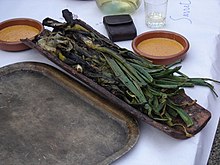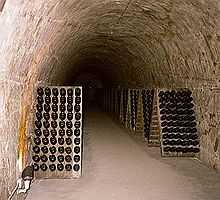Catalan cuisine
| Catalan / Valencian cultural domain |
|---|
 |


Catalan cuisine is the cuisine from Catalonia. It may also refer to the shared cuisine of Northern Catalonia and Andorra, the second of which has a similar cuisine to that of the neighbouring Alt Urgell and Cerdanya comarques and which is often referred to as "Catalan mountain cuisine".[1] It is considered a part of western Mediterranean cuisine.[2]
History
There are several
Hippocras (pimentes de clareya) was spiced wine made with cinnamon, cloves, ginger, pepper, honey and wine pressed through a manega, a pastry bag shaped cloth that was originally designed by Hippocrates to filter water.[8]
The 17th century manuscript El llibre de la Cuina de Scala-Dei, written at the Cartoixa d'Escaladei, contains austere recipes such as of porridges of cereals that go back to Roman times.[9]
Basic ingredients
Catalan cuisine relies heavily on
Traditional Catalan cuisine is quite diverse, ranging from pork-intensive dishes cooked in the inland part of the region (Catalonia is one of the main producers of swine products in Spain) to fish-based recipes along the coast.[11] These meat and seafood elements are frequently fused together in the Catalan version of surf and turf, known as mar i muntanya. Examples include chicken with lobster (pollastre amb llagosta), chicken with crayfish (pollastre amb escarmalans), rice with meat and seafood (arròs mar i muntanya) and cuttlefish with meatballs (sipia amb mandonguilles).
The cuisine includes many preparations that mix sweet and savoury and stews with sauces based upon botifarra (pork sausage) and the characteristic picada (ground almonds, hazelnuts, pine nuts, etc. sometimes with garlic, herbs, biscuits).[10]
-
Fruits from La Boqueria Market, Barcelona
-
Rovellons or Pinatells, a tasty wild mushroom
Savoury dishes

- Catalan-style cod (with raisins and pine nuts)
- Escalivada (various grilled vegetables)
- Escudella (a stew, it may be served as soup with pasta and minced meats and vegetables, or as the soup first and then the rest)
- Fricandó
- Ollada (meat and vegetable stew)
- Esqueixada (salted cod salad with tomato and onion)
- Mongetes amb botifarra (beans and pork sausage)
- Pa amb tomàquet (bread smeared with tomato and oil, and sometimes garlic)
- Tonyina en escabetx (tuna escabeche)
- Suquet (a seafood casserole)
- Savoury coca
- Mar i muntanya ("Sea and Mountain") dishes, which combine meat and seafood
- Embotits, a generic name for different kinds of cured pork meat, including fuet (a characteristic type of dried sausage), salchichón or llonganissa (salami) and different kinds of cold cut botifarra.
- Calçot (specially cultivated onion, grilled and served as a "Calçotada")
- Caragols a la llauna (cooked snails)
- Ammodytidae. It is the only species of this family in the Mediterranean Sea.[14])
Sauces and condiments

- Allioli, a thick sauce made of garlic and olive oil, used with grilled meats or vegetables, and some dishes. Allioli means garlic (all) and (i) oil (oli) in Catalan.
- Samfaina, also called tomacat or pebrots amb tomàquet. It is a variety of Occitan ratatouille or Spanish pisto.
- Romesco or Salvitxada (made from almonds, hazelnuts, garlic, bread, vinegar, tomatoes, olive oil and dried red peppers) from Valls.
- Xató, a variety of Salvitxada without tomatoes.
Sweets and desserts



- ; used to stuff a great amount of pastries, or to make simple desserts with, for example, fruit, and that is also eaten in a small flat pottery plate, after covering the cream with white crystal sugar and burning it, in order to create a layer of solid sugar that has to be broken with a small spoon before reaching the cream.
- Mató de Pedralbes or mató de monja is another kind of Catalan cream, similar to crema catalana, originating in Barcelona.
- Menjablanc or menjar blanc, typical of Reus but eaten all over Catalonia, is a kind of white cream made with almonds, from which a sort of milk is first obtained, followed by a cream to be eaten with a small spoon.
- Peres de Lleida is a typical dessert originated in Lleida composed of peeled pears cooked in a kind of lighter crema catalana and served cold, covered by meringue and decorated with cherries.
- Xuixos are fried pastries created in Girona and stuffed with crema catalana.
- .
- Pastissets, or casquetes, de cabell d'àngel are sweet half-circle shaped pastries stuffed with cabell d'àngel (a sort of marrow jam) and covered with white crystal sugar which are eaten at coffee time.
- Carquinyolisare little crunchy almond biscuits often eaten at coffee time.
- Catànies are Catalan marcona almonds covered with white chocolate and powdered black chocolate to be eaten with coffee.
- Pets de monja are small nipple-shaped and -sized biscuits also eaten at coffee time. At first they were called pits de monja (nuns' nipples) but time has changed their name to the current pets de monja (nuns' farts).
- Sweet coques were at first eaten only on holidays. Catalans have at least one type of traditional coca for each holiday and feast day of the year.
- Orelletes are thin fried pastries covered with sugar and eaten during Carnival. They also exist in nearby regions in Spain or France.
- Sweet bunyolsas bunyols de vent, bunyols stuffed with crema catalana or bunyols de l'Empordà are typically done and eaten on Wednesdays and Fridays during Lent.
- Mona de Pasqua is a pastry richly covered with almonds, yolk jam, chocolate eggs (or, currently, large chocolate sculptures) and coloured decoration that the godfather and godmother give as a present every year to their godchildren on Easter (Pasqua). It is an ancient pre-Christian tradition which marked the passage from childhood to the adult world. At first, it has one egg for each year of the children's age, and continuing to add one egg each year until twelve, as at thirteen they are no longer considered children.
- Castanyada, which Catalans celebrate on 1 November instead of Halloween. Their origin is Jewish, before the Middle Ages, but the tradition of castanyada is much older.
- braç de gitano (Gypsy's arm), that in Catalonia is always covered with yolk jam.
- A specific tortell is in fact a special tortell de reis (or galeta de reis in Northern Catalonia) a typical ring-shaped pastry stuffed with marzipanor Catalan cream (crema catalana) and topped with glazed fruit and nuts.
- Torró, a Christmas sweet made with almonds with DAO of Agramunt (Lleida).
- Neules are also eaten on Christmas in Catalonia. They are dipped in cava (Catalan champagne). They have the same origin as waffles and Belgian Goffres.
Wines

There are 11 Catalan wine-growing regions qualified by the INCAVI (The Catalan Institute of Wine):
The sparkling wine
"
Alternative views
Some Catalan authors, such as
Chefs and restaurants

Catalan cooks and chefs are widely renowned and critically acclaimed all over the world. Three of The World's 50 Best Restaurants are in Catalonia,[24] and four restaurants have three Michelin stars. The Michelin Guide Spain and Portugal 2022 edition awarded 49 restaurants across Catalonia with a total of 64 Michelin stars.[25] Barcelona has 28 Michelin stars across 18 restaurants[26] including Cinc Sentits[27] and has been chosen as the best gastronomical city by the American TV network MSNBC in 2009, topping the list of the ten best gastronomical cities in the world. In
See also
Notes
- ^ Sen, Miquel, et al, 2005, La Cuina comarca a comarca: Andorra-Cerdanya, Ciro DL. Barcelona.
- ^ [1] The New York Times, Spain: A Catalan Ole
- ISBN 9780857852175.
- ^ Lybre de doctrina Pera ben Servir: de Tallar: y del Art de Coch
- ISBN 9788400069209.
- ^ "Pollastre o capó rostit amb salsa de pagó". Fundació Institut Català de la Cuina.
- ^ Two Ways of Looking at Maestro Martino Gastronomica Spring 2007 Vol. 7 Issue 2
- ^ Pedralbes. Universidad de Barcelona.
- ISBN 978-0-907325-07-9. Retrieved 18 February 2024.
- ^ a b Pujol 2009.
- S2CID 153752556.
- ^ Sonso - Departament d'Agricultura, Alimentació i Acció Rural
- ISBN 84-273-6013-4. Planes 213-214.
- ^ Froese, Rainer; Pauly, Daniel (eds.) (2018). "Gymnammodytes cicerelus" in FishBase. February 2018 version.
- ^ PLA, Josep, 1970, 'El Que hem menjat', Barcelona (Catalonia)) (this edition 1997 Premsa catalana); photographs by F. Català Roca were added for the edition of 1981 by Edicions Destino, Barcelona.
- ^ Gastroteca.cat Interview with Jaume Fàbrega
- ISBN 978-84-7306-716-4
- ^ ANDREWS, Colman, Catalan cuisine pp. 3-4: "It is, to put it another way, the cooking of the region of Catalonia in northeastern Spain - and, by extension, of the historically and linguistically related països catalans or Catalan lands.."
- ^ gastronomy of the Catalan-speaking Countries: Jaume Fàbrega:"Belonging to the nation of Catalans Valencians and Balearics is not just a question of a common language: it is also a way of expressing that culture at table, of a culinary culture." Archived 11 October 2008 at the Wayback Machine
- ^ gastronomy from the Valencian Community Archived 9 May 2008 at the Wayback Machine
- ^ Gastronomy of the Valencian Community Archived 9 May 2008 at the Wayback Machine
- ^ Generalitat de Catalunya Archived 14 May 2013 at the Wayback Machine
- ^ Culturcat Archived 6 January 2014 at the Wayback Machine
- ^ "Spain's El Bulli named best restaurant in world". The Economic Times. India. 21 April 2009. Retrieved 30 April 2012.
- ^ Jordan, Guifré. "Three Catalan restaurants maintain their three Michelin stars". www.catalannews.com. Retrieved 25 December 2021.
- ^ Doherty, Lorcan. "Interactive map: All Michelin-starred restaurants in Catalonia". www.catalannews.com. Retrieved 25 December 2021.
- ^ "ViaMichelin Barcelona Restaurants: online restaurant guide". Michelin Guide. Michelin. Retrieved 12 February 2012.
References
- Andrews, Colman, Catalan Cuisine. ISBN 1-55832-329-5
- Fàbrega i Colom, Jaume, Traditional Catalan Cooking. Edicions de La Magrana, 1997, ISBN 9788474109641
- Lladonosa i Giró, Josep, The Book of Catalan Kitchen. Alianza Editorial, 2007, ISBN 84-206-0354-6
Further reading
- Pla, Josep (1982) Aigua de mar, 3rd ed. Barcelona: Edicions Destino
- Pla, Josep (1984) Alguns grans cuiners de l'Empordà. Barcelona: Llibres a Mà
- Pla, Josep (1981) De l'Empordanet a Barcelona; 2nd ed. Barcelona: Edicions Destino (1st ed. 1942)
External links
- Catalan recipes in English
- www.eatcatalunya.com
- www.lacuinacatalana.com (in Catalan)
- DOP IGP Salchichón de Vic or Llonganissa de Vic (in Spanish)


